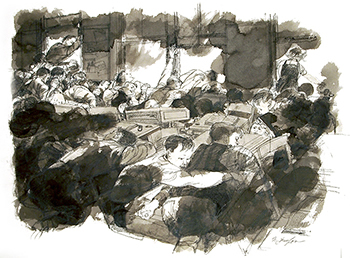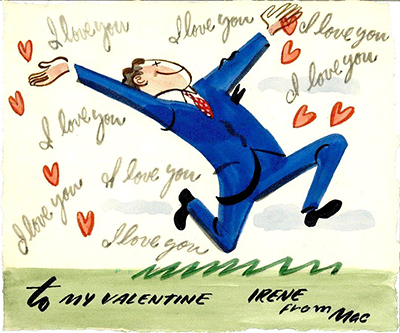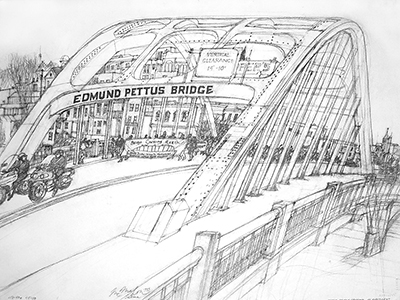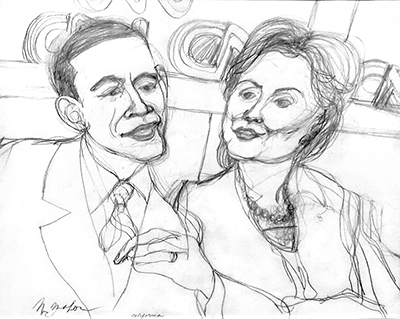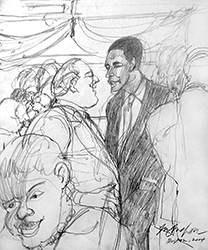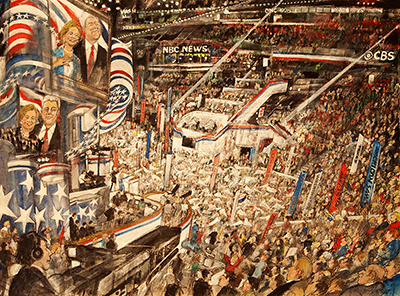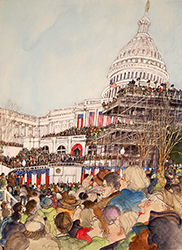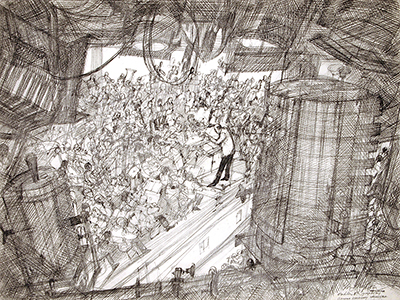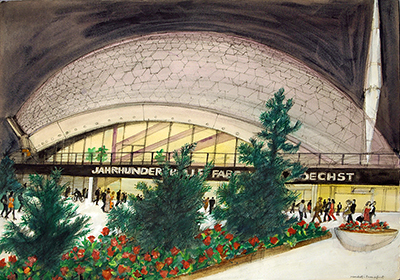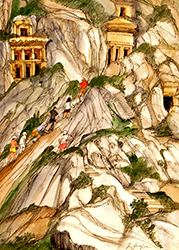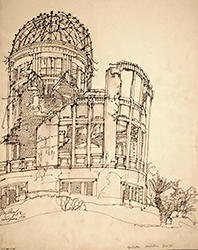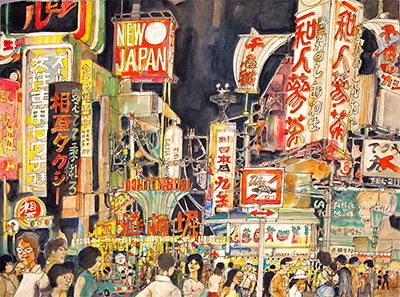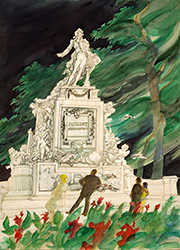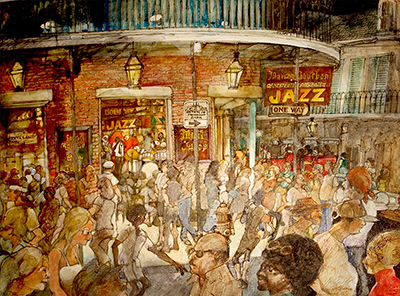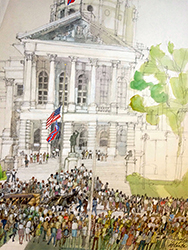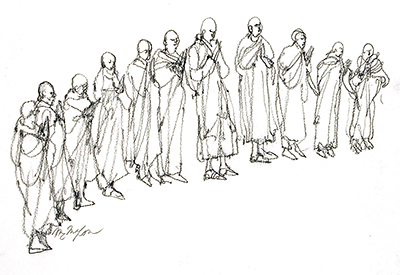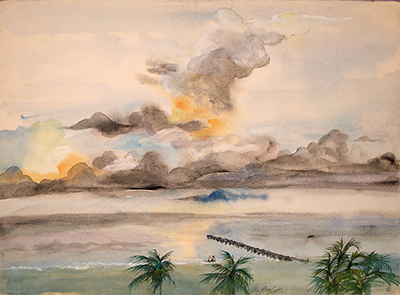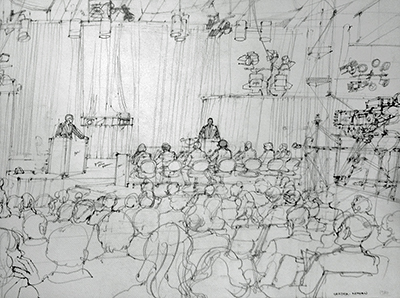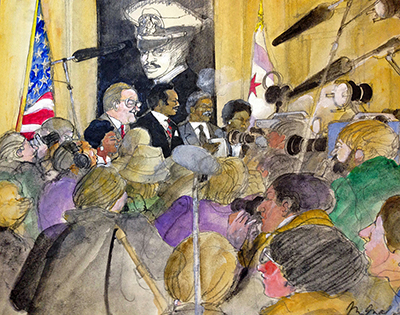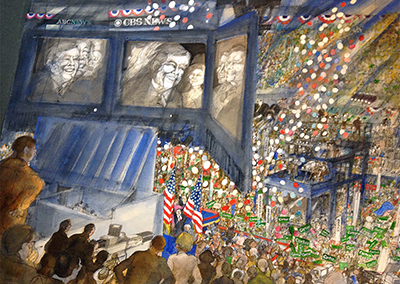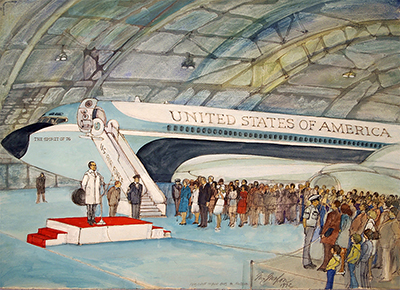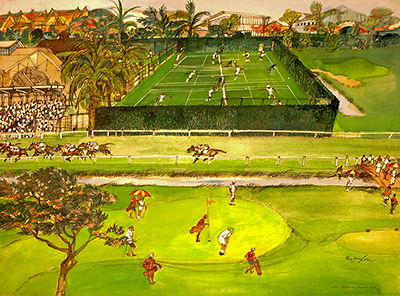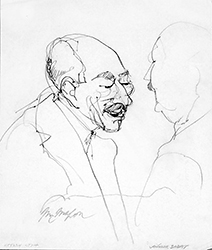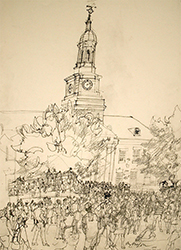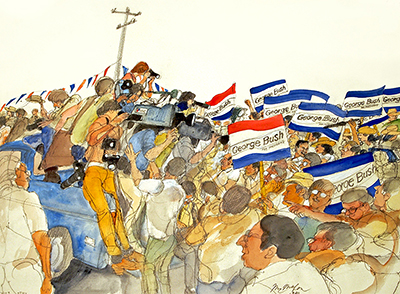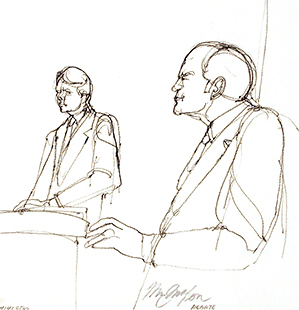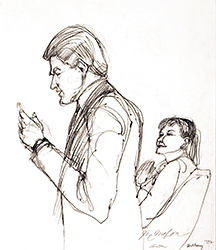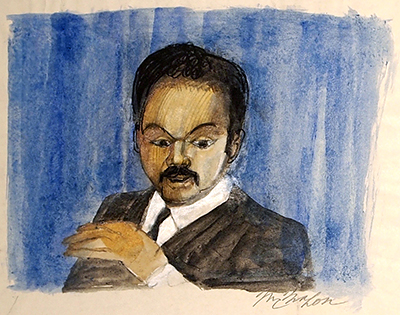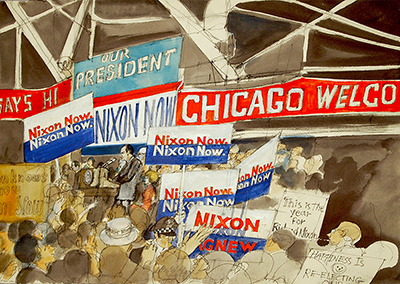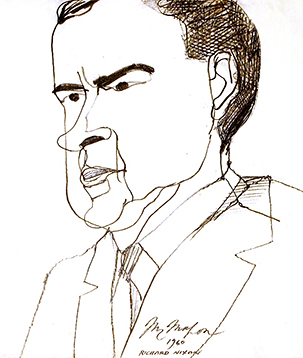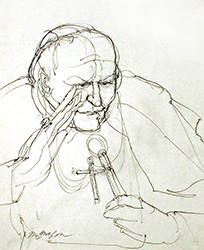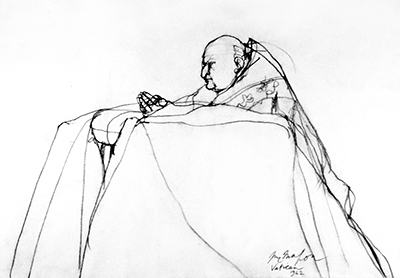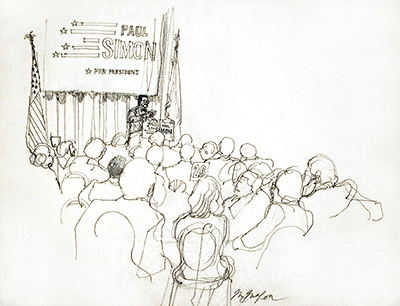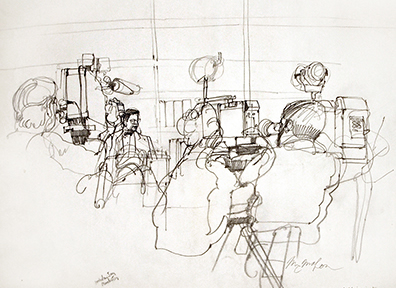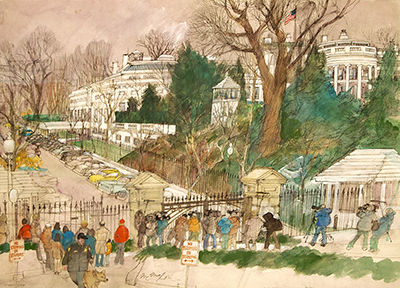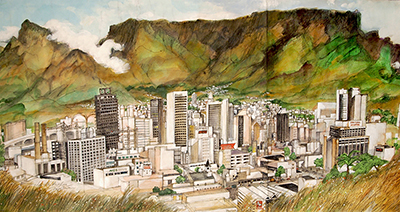|
||||||||||||||||||||||||||||||||||||||||||||||||||||||||
1960s | 1964 | 1964 to 2011 | 2012 |
||||||||||||||||||||||||||||||||||||||||||||||||||||||||
| 1960s We had just moved from our passive-solar home on Greenbay Road to Spanish-style Airdrie on Mayflower Road with my youngest brother in Mom’s arms. The front staircase, with a landing and large bay of stained-glass windows, fascinated us for days and weeks. Knowing that drawing the news was being overtaken by photography, Dad was gearing up to cover the debate between telegenic, tanned John Kennedy and haggard, unshaven Richard Nixon for Look magazine. Here, I learned to respect how my father spoke with silence. I learned to interpret his thoughts and moods through his body language and the sound of his footsteps. Here, I never heard my parents argue. |
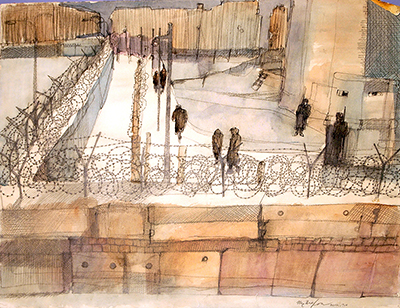 Berlin Wall, 1964, Looking East at Night Painted in Germany; published in the Chicago Tribune. Acrylic on paper. 14” x 17”  St. Michael’s Church Divided, 1961 The church was half in East and half in West Berlin. Graphite and acrylic on paper. |
|||||||||||||||||||||||||||||||||||||||||||||||||||||||
|
||||||||||||||||||||||||||||||||||||||||||||||||||||||||
| 1964 Gramma Mac faced the front hall mirror and brushed a rosy powder over her sunspots, tidied her pink lipstick, and slipped the pearl-handled pistol from her ivory purse onto the narrow shelf under the marble table. She reached for a wide-brimmed, finely woven spring hat, a rain coat and an umbrella. She glanced in the mirror, adjusted the hat brim as she lifted her keys from a hook and picked up a bag of transistor radios for her grandchildren and counted them, “Yes, there are nine.” Gram paused to look intently into the mirror and pursed her lips while saying “Prunes, Prisms and Papa’” to order her mouth into the right position to appear in public. She briskly locked the door, walked down the plush carpeted hall and called for the elevator by pushing a brass raised button. “First floor,” Gram quietly smiled to the elevator attendant. She nodded a greeting as he lever-closed the diamond-shaped metal grill door with a clatter. After a jerky stop, he dialed the lever left and right to reach level with the ground floor. “Good morning!” my grandmother cheerfully greeted the doorman, who chatted, “Good morning, Bess; you’ll need your umbrella today. Glad to see you’ve got it.” Gram was lost in her thoughts, “Lets see... I've got to pick up the cake, mail the letter to Jack, drop off the tailoring before the drive to Lake Forest to visit Mac and the kids after Mass.” Gram tipped her hat and umbrella to the doorman, who opened the brass door, and left her building. She gave a distracted glance towards the misty Water Tower and Michigan Ave in the early spring rain. On her short walk to the parking garage, she balanced her umbrella over the bag of radios, dropped a letter to Jack into the mail box, and pondered, “I'd like to take Sheridan road along the lake, but I’m late, so the Edens highway is the quicker choice...” |
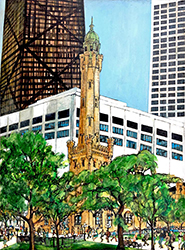 Water Tower, mid 1980s Acrylic on panel. |
|||||||||||||||||||||||||||||||||||||||||||||||||||||||
| Under certain circumstances there is no other day as desirable as Sunday. ‘The Lord’s Day,’ a day of rest and fasting, of communion and dinner with family. On this particularly splendid spring Sunday morning, the Lake Michigan breezes blow altocumulus clouds east over the shoreline, casting shadows on a stately home that stands with its back to the lake. A redtail hawk silently soars over the beaches and steep cliffs that rise to maple and oak woods to cast a shadow on the gabled windows and the few chimneys that ascend from a terra cotta roof. Ivy climbs the roughly textured gray stuccoed walls. Leaded windows with handled latches are occasionally and slightly open. In the center of a first-floor bay of windows is a double door overlooking a long wide lawn. This bay offers morning sun in which to sit and capture a quiet, restful moment in the desire and yearning of a weekly visitor.
This house is named ‘Airdrie.’ It stands facing an acre of trees secluding it from Mayflower Road. The gesture of this home is welcoming and warm, with outstretched ceramic-tiled roofed wings that embrace the visitor into a high-walled courtyard. Though lined with windows facing east, Airdrie gestures westward to a winding drive through a forest that bows in the breeze to the grand old oak in its courtyard. The hawk settles on one of the oak’s far reaching branches that dapple the sunshine on the pea gravel courtyard. The springtime wafting flavor of tulips and forsythia create an air of expectation for Gramma Mac’s large brown Packard, soon to park under the oak’s branches. A Volkswagen van, barely containing a boisterous family of 11 returning home from Sunday Mass, enters through the narrow gate. “Cut the flak,” Dad stated as he drove all eleven of us up the long driveway. The side car door slides open, releasing four boys, in penny loafers, wearing school uniform slacks, white shirts and skewed clip-on ties. The third of four girls, lucky number seven jumps, with black patent leather shoes and lacy white bobby socks, into the thick pea gravel, landing to make two divots. Three girls follow, with the oldest lifting the youngest to the ground. Their shouts are an explosion from the crowded van and eternally long mass. Turtle candies, tiny green army men with parachutes, a balsa wood plane kit, rolls of black and white film, and a paper kite purchased during the Walgreens drugstore visit are clutched in the young hands. The hawk ruffles its vanilla-colored breast feathers and settles onto the branch. “ Grandma Mac will be coming soon!” Irene, their mother, in high-heels and a paisley dress, lifts down her youngest son and announces to the teeming crowd, “Change into play clothes. Supper will be served at 3:00. Roasta Beefa at 3:00!” Inside Airdrie’s Spanish style courtyard settles a dark-paneled home, both grand and comfortable. Tall ceilings over hand-plastered walls and dark-stained oak paneling are graced with art pieces collected from world travels of the current and previous owners. A leaded glass star fixture hangs in the bay before the door to the back lawn, where Dad is helping a brother assemble a kite. Two stuffed tea chairs and a table fill the sunny bay. A New Yorker magazine lies on the table, awaiting an expected Sunday visitor. Three little kids in pedal pushers play around the abandoned newspaper sections on a very long couch that faces the oak fireplace. Eleven finishing nails have been hammered under the mantle in expectation of Christmas stockings. After the pillows are cleared off the couch, the springs became a trampoline —until the door bell rings. “Gram’s here!” “Mom! Gram’s here!” They open the bay door and call to the back yard, “Dad. Everybody. Gram’s here!” The New Yorker is knocked to the floor. Mom unties her apron, by habit looks through the eye-level spy hole to see an ashen faced mother-in-law, then quickly opens the heavy, carved oak door. “Bess, is everything all right?” she greets Gram with a hug. “I may need a strong little-something. I’m a bit rattled, Irene.” Gram responds, her auburn hair slightly mussed. Later that afternoon, at the dinner table twelve McMahons recite “Bless us oh Lord, and these, thy gifts, which we are about to receive from your bounty through Christ, Our Lord…” over their interlocking fingers. The table is a length of the Lake Forest Bowling Alley that closed the previous year. The long length of laminated wood still shows the dings and divots from dropped bowling balls. Two cast iron sewing machine peddles hold the alley at the right height for most of the children. Press-backed chairs with cane woven seats encircle the table. The five-door black-and-white enamel oven has a series of recently used and nearly empty pots on its eight-burner gas range. “Amen,” they all end and the clatter of forks ensues. Now listen carefully to ourfamily’s names: Irene, or Mom, who sits at the refrigerator, or east, end of the table, is gathering the plates and placing the stack in the enamel sink. To her left and in order, sit Michael, Gramma Mac, Debbie, Michelle and Hugh. Dad sits at the west end. To his left sit Mac Jr., Mary, Margot, Mark and Patrick. It seems family dinners will continue like this every night, but change is inevitable. Dad’s latest brown paper packages are slumped, with worn edges and torn corners, against the cupboards behind his pressed back chair. Before dessert, he’ll get up and lift one drawing from the package. What came out of the packages was a World’s Fair of images not seen in our nation’s heartland. We saw boys playing soccer in Egypt or the Red Rock in Australia, a bamboo scaffold used to build skyscrapers in China, and Japanese letters in neon lights in Tokyo. He’d show and tell us about the Bishops Synod of Vatican II in Rome, Robert Kennedy’s ambition, Martin Luther King, or a Continental Bank in London. We learned compound phrases, Embrace ecumenical and We shall overcome. He showed us the wonders of the world through pencil on paper and told stories of what it was like to be there. In doing so, he gave us an international understanding of the world that promoted in us world peace and the wonder of other religions and heritages. Images of historic moments on heavy paper, captured by a veri-black pencil and watercolor paint. Dad captured on paper, graphite emphatic gestures and likenesses of Eisenhower and Goldwater, JFK’s funeral, MLK ’s freedom speech, LBJ’s mutual contempt with Bobby Kennedy. He later explained the speeches from “a guy like Babbit, or Dukakis. or McGovern, or Hillary, who didn’t make it.” His lyrical lines captured their body language, facial expressions. Gram moved to California, a brother went to college, then another away to high school, marriages were celebrated, babies were born, more left for college through the following decades. Dad and Mom traversed the globe capturing change while the three little kids grew up History came to life as Dad described the Korean War, the Bay of Pigs, and the Civil Rights movement. He explained President Johnson’s War on Poverty with Head Start, Legal Aid, VISTA and then the Peace Corp with his infectious excitement and insightful humor. This wonder of the world being rebuilt is why he had fought in the war. He showed the changed political, religious and economic atmosphere of rebuilt skylines of cities in Africa, America, Asia, Australia and Europe in drawings. He showed us through his art what it felt like to be in the presence of Pope John XXIII at Vatican II and the Dalai Lama at the International Conference of Religions. Wonders he witnessed of the tectonic plate changes of a world’s free society in the 1960s were published through newspapers and struggling magazines. “I spoke to some of the Life guys in New York about it,” Dad said. “They didn’t realize that television was a turning point.” Dad stayed home for a brother’s eighth grade graduation the day Robert Kennedy was shot. |
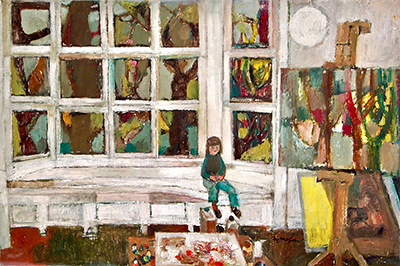 Margot at Mayflower Portrait of Margot, 7 years old, in WFM Lake Forest Studio Margot sat for the portrait. 1964. Encaustic. 22” x 30”  Airdrie on Mayflower Linoleum block print for a card.
|
|||||||||||||||||||||||||||||||||||||||||||||||||||||||
| These stories that he had told us became films. He had a crew in his studio to pan across the cityscapes, crowds and events drawn to show how it felt to “be there.” The active lines captured the energy of the room and the cadence of the music. Mom taped the audience’s reflections and added their impressions in voiceover. American City at Christmas Time told a broader audience of a dichotomous cathedral mass blessing and Reverend Jesse Jackson chanting in a jail, “I am somebody. I may be poor, I may be unemployed, but I am somebody!” Real Violins captured the Chicago Symphony Orchestra, conducted by Sir George Solti, becoming World Class as the result of a tour through Europe and Japan. Dad transformed a room off the courtyard portico, added a phone line and answering machine, and his film company, Rocinate Sight and Sound, was founded.
“What do you think of this?” Dad asked from this office desk. “It looks like a horse rearing up,” I answered of the abstract line drawing. “That’s okay. Can you see a horse’s head as well?” “Oh yeah! I see it now.” The line drawing of a horse’s head was his new logo for stationary. |
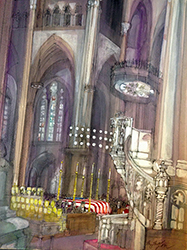 Robert Kennedy Funeral Mass, St. Patrick's Cathedral, June 8,1968 Graphite and acrylic on paper. 33” x 22” |
|||||||||||||||||||||||||||||||||||||||||||||||||||||||
| 1964 to 2011 One Sunday evening after dinner we all walked through the front woods, past the fallen oak, under the treehouse, between the tennis court and greenhouse, to the home of the Harkins neighbors and their color television. Dad’s first movie was on WTTW–Channel 11. We crowded around the giant color screen with its built-in console speakers on either side to see our first color television show. Dad’s documentary earned him a Peabody Award. Later, we watched the awards on our black-and-white television at home, hooting and hollering when he rose, then hushing silent as he thanked his wife and collaborators. Franklin McMahon was inducted into the Society of Illustrators Hall of Fame, and his artwork was collected by museums throughout the country, including the Smithsonian National Gallery, the Art Institute of Chicago, and the Chicago History Museum. He was an Illinois State Treasurer and earned honorary degrees from Lake Forest College and Loyola University in Chicago. Dad was a medaled Army Air Corp Veteran of WWII, and exhibited his art worldwide. His major bodies of artwork are: 1) World Studio, images from countries throughout the world; 2) Politics, including portrayals of presidents from Dwight Eisenhower through Barack Obama and many candidates in between; 3) Civil Rights, from the Emmet Till trial for Life magazine through the Barack Obama–Hillary Clinton debates; 4) Vatican II, from Pope John XXIII through Pope John Paul II. Franklin McMahon’s films can be found at the Chicago Film Archives. They include:
|
|
|||||||||||||||||||||||||||||||||||||||||||||||||||||||
|
||||||||||||||||||||||||||||||||||||||||||||||||||||||||
2012 As Dad’s energy dissipated over the years, the spiral of what he was, what he created, started to churn like a maelstrom slowly building. The maelstrom was us, like a plate with nine pie sections spinning on a thin pole above a colorful clown pedaling a unicycle. Each of us had one connection to the remaining parent that was complicated by over fifty years of family life. He’d been the apex striving to maintain himself in the three-ring circus of working at home to feed, cloth, drive and guide eleven. Accommodations to opposite sides of our plates kept the fine balance of a family spinning, to keep us from tumbling. Waning in energy, needing physical and emotional support, he masterfully knew how to keep the right amount of spinning to level our lives. Years of our spinning with strong ideas of survival, justice and injustice. Dad said it was okay. Is it legal? Does legal matter? Let things take their own course and the right thing will happen. How much to control and how much to let go? How much do we cheer him on to fight back through physical therapy? “I’m ready to go, let me go,” he said. There is no argument, but there is fear of the unraveling of this tension on a thin pole that could bind us or spread us to the furthest corners of our rivalry. Whom did he love more? A sage quietly sitting, while letting go of art and life. One at a time we’d visit. Two at a time we’d intersect there. If one visited more, did he or she have more say in his care? Were our actions of love and care from what we could receive from, or what we could give to, Dad. Who knew the right amount to visit, or cling, or take, or ask? This was a slow up and down. There was time, this way, to adjust. As if anyone is ready for the reality. Many scares and many times of knowing this might be the last stroke, the last time I’d see the always active artist’s hand, limp with only a tremor of a movement exerted from concentrated effort. It was a constant tug of not being there enough, not knowing enough stories, not bringing enough to encourage him. I paused on my way to visit him one afternoon, to absorb the magnificence of a falcon trapped in our chicken coop. Its claws clung to the chicken wire ceiling, baring vulnerable brown spotted down on a creamy underbelly. The wings flapped upside down. Its herringbone markings were inverted with open wings bent by the enclosure. A lifeless house sparrow lay in the grain not eaten for breakfast by the gentle, murmuring hens. My presence exacerbated the peregrine’s vulnerability into a flapping panic. When I stepped away, it found the courage to glide from its cooped entrapment. I saw Dad in this falcon, trapped in life, waiting for his moment of release.
|
 Helicopter Encaustic on Masonite. c. 1957. 23" x 35" |
 Unicycles Painted in Quebec, Canada |
||||||||||||||||||||||||||||||||||||||||||||||||||||||
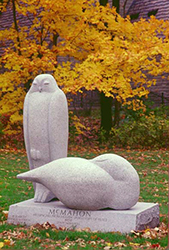 Hawk and Dove,1997 5’ x 5’ x 3’ granite Margot McMahon carved for the family burial site in St. Mary’s cemetery, Lake Forest, Illinois. Hawk is St. John the messenger that flies to heaven to bring to earth a message; the contrasting Dove is a symbol of peace. Both are at rest. |
||||||||||||||||||||||||||||||||||||||||||||||||||||||||
| —page top— | ||||||||||||||||||||||||||||||||||||||||||||||||||||||||
The Eternal Optimist | Parachuting Artist | Cut the Flak | Blog | Home |
||||||||||||||||||||||||||||||||||||||||||||||||||||||||
|
For further information or to purchase art please contact: Margot@FranklinMcMahon.net MargotMcMahon.com
|
||||||||||||||||||||||||||||||||||||||||||||||||||||||||


